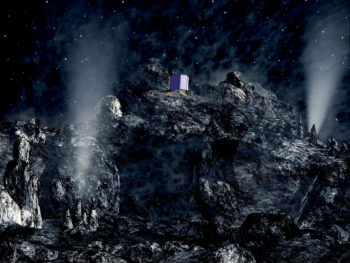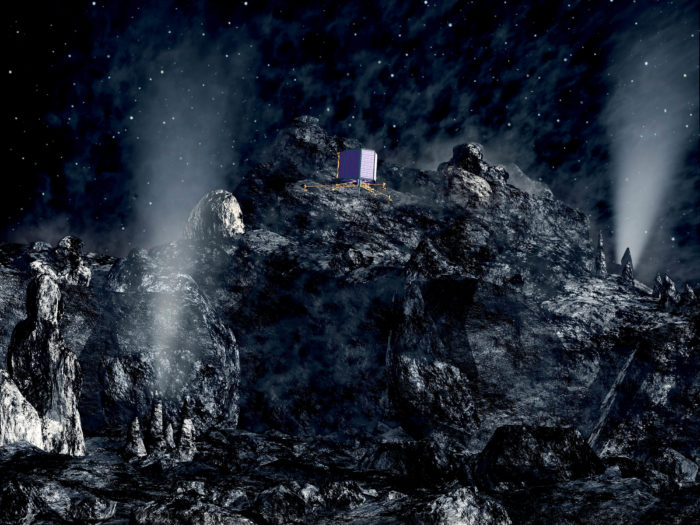Shields, Starship Combat, and Outer Space Fortresses
This post is part of a lead-up to fully getting back in the swing of the Speculative Fiction Writer’s Guide to War. Its information will probably be used in the final version of the book I intend to produce for the Guide to War, but isn’t one of the numbered articles. It starts with talking about shields and then makes a number of observations about what spaceship combat will probably be like. Note that this post, yet again, has been adapted and considerably expanded from an old article on my personal blog. It’s also very much hard science fiction and is based on ideas that come from my own personal thoughts about the future of technology. FYI–hope you find it interesting.
Shields
Shields, forcefields, and screens of various kinds adorn much of science fiction, especially stories that feature interstellar travel. There’s a technical reason why this is so that comes up even before we start talking about space combat. As per the linked New Scientist Article, while there are on average only 2 hydrogen atoms per cubic centimeter in the vacuum of space (Earth’s atmosphere at sea level is 15 billion billion times as dense), a starship going near-light speed would slam into so many of these hydrogen atoms so quickly, with such a huge energy differential between the starship and the hydrogen, releasing so much gamma and other radiation as a by-product, that it would be like standing directly in front of the business end of the Large Hadron Collider when powered up full. At such a high percentage of the speed of light (say, 90%), a human being would receive a lethal dose of radiation in far less that a second from the side effects of bits of matter out in the not-quite vacuum of space hitting the craft. Shields are supposed to fix that.
Shields or force fields or force shields or screens or whatever else they’ve been called in fiction for the most part imagine some future design using a force unknown to today’s physics that conveniently blocks all that pesky radiation–and which can also defend against enemy weapons. Generally such shields are portrayed (say in Star Trek or Star Wars) as requiring energy to maintain, as blocking pretty much anything as long as they are up, as weakening when you fire into them until they reach the point of collapse, at which point shields are down and you’re vulnerable to attack. Visually they’re usually shown as a glowing or reflective layer that goes around a spaceship. Perhaps it will not surprise you as you read this to hear there’s nothing known that can do all the things these types of fictional shields are supposed to do. After all, this is fiction, right?

Defensive shields shown for Star Trek Voyager. Image rights: Viacom
Yeah, but having enough energy to move at a high percentage of the speed of light is not fiction. Antimatter is real and could work in starships (though it’s dangerously unstable). Fusion power is again, real, though we haven’t mastered using it consistently, but it could easily power a starship. Warp drive designs are real, too, though they require something called “negative energy density” to work, which has never been shown to actually exist. Still, we (“we” as in the collective body of human knowledge) know what it would take to produce a warp drive field and can easily imagine getting something with the required “negative energy density” and putting it to use. And space weapons can work, from lasers to guided missiles or torpedoes or even the rather lousy blasters used in Star Wars could work as packets of plasma shot from a weapon. Pretty much everything else in a convincing science fiction story works–but shields don’t (transporters don’t work, either, but we’ll address that another time).
So if we want some realism in our space-based stories, if we want to be able to talk about outer space with at least a veneer of technical plausibility, we really need to do something to fix shields. And since we do in fact wind up lacking realistic shield technology, we need to discuss how that would affect space travel and space combat.
The best realistic candidate for something at least a little like shields would start with putting a powerful magnetic field around a spacecraft as step one. Step one by itself will protect the craft to a degree. Any charged particle (i.e. ions and free electrons) in space will get trapped by a strong magnetic field alone. Though such a field would do nothing to stop lasers or high-energy gamma rays for even an ordinary bullet made out of a non-magnetic substance.
If you deliberately released a large quantity of very hot ions into the electromagnetic field I mentioned as step one, you’d have something called plasma shields. Plasma is matter so hot it has lost its electrons–i.e. matter that due to high heat has a positive charge, i.e. matter that an electromagnetic field can keep away from your spaceship and around it to protect it. That’s kind of like shields in Star Trek, right? Eh, yes and no.
It’s like shields in that you have to keep pouring energy into the system to keep it up and it would go around the ship. It’s also like shields in that it would provide at least some protection while operational. But pouring more energy into plasma shields wouldn’t really hurt them, though, unless you shot the electromagnetic field generators. If the electromagnetic field did go down, the plasma released could easily damage your own ship! Which is not an effect seen in science fiction that I know of. Though having a lot of very hot plasma right near your ship would create a heating problem within the ship anyway. That coupled with the fact it’s pretty hard to get a magnetic field to conveniently hug the surface of your hull (magnetic fields tend to come in spherical or ellipsoid shapes), you might want that plasma shield to be as far away from your spaceship’s exterior as you can realistically put it.

A Federation starship surrounded by a realistic-looking magnetic field. Image copyright: CNN
Plasma would have to be very hot and relatively dense to have a major effect on even small bits of regular matter shot your direction. And even having an effect may not be beneficial to your defense–is it really better if an enemy shot lead bullets at you and your plasma shield melted them into liquid lead flying your way? Because the plasma is not going to actually block the movement of ordinary matter, though it can heat it. If it heats it enough to make it into plasma, the electrical field will control its motion. But heating a fast-moving substance so quickly in a limited space is actually hard.
Also, to block energy beams, plasma shields would have to have ions tuned to block specific frequencies, because blocking all frequencies is simply something plasma doesn’t do on its own (I’m referring to different chemical elements blocking different segments of the electromagnetic spectrum). Gamma rays probably would pass right though plasma without damaging it, no matter how much work you put into fine-tuning the chemical composition of the shields. So would certain frequencies of laser and all neutron radiation. Blowing up a nuclear weapon just outside of your plasma shields may not knock down the plasma shields themselves at all, but the radiation of the weapon would go right through them and kill the crew in the vessel anyway! Which is definitely not how shields are shown in most science fiction.
Plasma shields come with so many limitations and downsides I anticipate that if given the choice of using plasma shields or not using them, many science fiction starship builders (in hard sci fi stories, of course) would simply opt out of using any shields. Note not using shields doesn’t mean starships could not exist. It might limit their velocity, to say, 10% the speed of light. Using wormholes or “gateways” could make traveling anything near the speed of light unnecessary anyway.
Do other realistic options for shields exist, other than plasma shields? No, not really. I’ve read stories that portray shields as an effect of time dilation, so objects or beam weapons trying to enter the shield get trapped in a land where time stands still. But how do you generate such an effect? What would take it down? (I would think nothing would) How would you move it around? How would a starship function inside of it? None of those questions are answerable, so time dilation shields and all other designs I’ve ever heard of other than plasma shields can be dismissed as the equivalent of magic-in-space. (And I realize magic-in-space may work for some of you–but if you want a bit more realism, keep reading.)
Space Combat Without Shields
Human beings, assuming the apocalypse doesn’t come first, sooner or later will likely design vessels that travel between stars. And before that, in between planets. We can imagine these future humans will have no need for weapons, space fortresses, and space vessels designed for combat. But a brief examination of human history strongly suggests that wherever human beings go, warfare and instruments of war go right along with us. Not to even bring up the subject of aliens.
So, since the standard sci-fi fare of screens and fields won’t work, what will? How do you defend a starship against attack? Let me suggest the following five ways:
Starship Defense Techniques
- Dispersion. As noted above, very powerful weapons including lasers, nuclear bombs, and antimatter torpedoes are all solidly either in existence or established as something that would really work. How do you defend against such weapons without the use of shields? In fact, the best way to survive an atomic or similar blast is not be there when it goes off. Building a vast array of little outposts separated from one another by a healthy distance is the best way to defend against any single form of attack. In Star Wars terms, a million TIE fighters is much better for defense than a single Death Star, assuming you keep each little fighter further away from one another than the radius of an atomic blast. And building and dispersing many, many small fighters may take around the same resources to build as one massive station. Note though that Star Wars blasters and other weapons as they are portrayed are not only weaker than the Hiroshima blast of 1945, they are, with the exception of the Death Star itself, much weaker–likewise with Star Trek weaponry generally–so give your million defending little ships some realistic weapons, including nukes, or else they would wind up becoming nothing more than space junk.
-
Decoys/ECM. Related to point 1, sending out as many as possible robotic decoys that employ electronic signatures like the main ship would provide a way to draw off an enemy’s devastating ability to attack. The chief difference to this approach from number one is that decoys don’t necessarily have any combat power, unlike the dispersion method. Note the use of ECM/Electronic Counter-Measures is similar to this, sending out decoys that only exist electronically as a means meant to fool enemy sensors. Though ECM can also try to disable or disrupt enemy weapons to keep them from working (If the enemy is shooting at something other than you in combat or his weapons won’t fire or can’t aim, that’s a good thing.)
-
Disguise, a.k.a. “cloaking devices” or “invisibility cloaks.” The Star Trek universe treats shields like they are standard technology that virtually everyone has, whereas cloaking devices are advanced technology only a few species have mastered. From a scientific viewpoint, they have it backwards. The Pentagon is already experimenting with an invisibility cloak. The thing works, right now, but only for a fraction of a second at a time. Consider though that the basic idea behind and invisibility cloak is to project what is behind you to being in front of you as if you were not there at all. Essentially it amounts to having cameras behind you and projectors in front of you. This is complicated, especially if you are trying to decoy from all possible angles, but doable. You can be sure when spaceships are able to hurl weapons at one another with mega- and gigaton level equivalents of TNT (nuclear weapons and antimatter bombs), starships with be protected with cloaking devices. Space warfare would likely become largely like submarine warfare of our age. The biggest part of the battle could be simply finding the other vessel through all the decoys and cloaking technology and successfully firing first. Combat probably would amount to the first on-target torpedo strike and that’s it, the battle is over. Perhaps.
-
Mobility. Yes, there is probably an absolute speed a space vessel can practically go, but consider that the position of a craft is known by light coming away from it to a potential attacker. So since with torpedoes/guided missiles, enemy starships could fire at one another from distances that require light minutes if not hours or days to travel, that means that any light providing sensor information about where the vessel is would also be minutes or hours old. If a vessel is moving at a significant fraction of the speed of light (say, 5%) and is far enough away, an attacker can only guess where a starship might be based on last known location and whoud not know where it actually is. It’s challenging to engage a target if you don’t know where it is–and would mean beam weapons would become especially ineffective from that range. Note that closer than a light second away or so, automatically targeted beam weapons (assuming powerful lasers on board starships) would hone in on vessels quite easily and make mobility pointless. But unless spaceships had no guided weapons to launch from further out, it would seem to me they would never have a reason to close the distance that much with enemy vessels.
5. Armor / Plating. there is no such thing as a material that can block the effects of a nuclear bomb up close and there probably will never be. But simply having a mirrored surface on the outside of a craft would help against beam weapons–though to be truly helpful, the surface of the ship would have to be able to reflect high energy photons from x-rays and gamma rays, too (which is really hard) as well as block infrared and microwave radiation on the other side of the visible spectrum. Materials in the hull that block radiation as well as possible and which will resist high-speed particle weapons is also better than nothing.
What would starship armor be made of? Composite materials. Whether a future space force adopted the strategy of a massive body that’s tough to kill or a plethora of smaller craft that are hard to find, you’ve got to build the vessel out of something. Our knowledge of modern sailing ships might lead a science fiction writer to assume spaceships would be made out of metal. But of all known materials, carbon has the strongest bonds. It is therefore the most resistant to direct damage and has a very high meting point. It’s very difficult to damage by heat alone. Certain plastics are surprisingly good at absorbing radiation and a thin film of gold is good at blocking radiation as well. Make a composite of materials like this sandwiched for various effects, including reflecting beam weapons as much as possible, and fill in layers with water in a system designed to vent superheated H2O to protect from heat produced by a nuclear and other blasts. The use of water would go a long way towards protecting the surface of the composite material. A design like this probably can’t keep a future space combattant entirely safe. A nuclear weapon does an incredible amount of damage. But it certainly would help against indirect hits. That’s much better than one hit of any kind and you’re dead…
So the picture of future space combat as I’m describing it shows a variety of techniques could work, but that maintaining distance to a degree, trying to be the first to find the enemy while both sides are cloaked, while also keeping moving in difficult-to-predict directions to enhance protection against beam weapons (assuming a distance of light minutes or more apart) would be major features of future space combat. This is not like either Star Wars or Star Trek, but I would say isn’t boring at all. Stories that portray this kind of combat realism in space could have a lot of white-knuckle terror and near misses as enemies fire off nuclear weapons relatively close by–a bit like depth charges versus submarines in old movies.
So if that’s how combat would work for space ships or starships, how would it work for space stations, the “Outer Space Fortresses” I referenced in the title of this post, places in space without any significant engine power? Let me suggest 3 methods unique to stationary defenders.
Outer Space Fortress/ Space Station Defense Techniques
First let me note that while mobility or dispersion clearly won’t work for defenders whose only motion is orbital velocity, some of the other techniques I mentioned will. Certainly decoys and ECM would seem very much helpful to space stations. Cloaking might also help to a degree, but for something in orbit and little in the way of other mobility, the enemy only has to find you once to know where you will be from there on out. But some techniques exists that a station could use but a starship could not. I’ll mention three below:
- Natural body protection. Burying a base deep within a iron-nickel asteroid provides pretty good protection. The thickness of the natural metal around the base at the core of the asteroid would protect from a lot of radiation and other kinds of impacts. Yes, an antimatter torpedo does have the blast power to split an asteroid open, but by nature most of the blast power against the surface of a heavenly body would radiate out into the vacuum of space. As per the movie Armageddon (maybe the only thing Armageddon got right as far as science is concerned), drilling into the asteroid to crack it would be more efficient than blasting it from the outside repeatedly (though that would eventually work). Though of course you could still attack whatever weapons are on the surface of the asteroid, rendering it a worthless rock in space. Then afterwards dropping drilling teams on the surface trying to dig a tunnel to blow it up or get down to the defenders–if the asteroid held such a strategic position that you could not tolerate defenders from inside the asteroid rebuilding its weapons someday. These drilling teams could be counter-attacked by teams from below the asteroid surface. Space infantry could become the most important element of such a battle for an asteroid (though if it were up to me, I’d send robots to do the drilling).
2. Mass. Yes, this is part of the advantage “natural body protection” has going for it, but could also apply to an artificially constructed defensive station. While it’s hard to build something on a realistic scale that can resist damage by mass alone, building much bigger than realistic, as in Death Star size, has some advantages. Make a smooth and reflective outer surface, plated so that it would be resistant to drilling and radiation and many other forms of attack, make one that would be very difficult to drill into, covered with so many weapons that destroying them all would only come with considerable risk. The problem of course is the bigger you make it, the harder it is for it to move, meaning the easier it is for an enemy to simply bypass it. That means you’d probably only build such a massive thing in orbit of a home planet. Better build at least 3 to orbit your home world in a triangle formation, lest an enemy swing around to the opposite side of the planet from your space fortress and attack the home world at will. Note though I still think building a million or billion small defenders would be better than building three massive artificial moons to defend a planet, but not everyone would think like me, especially societies adverse to any kind of loss. Note how Star Wars gets this backwards–the Death Star is an instrument of attack, when using it for defense goes much more along the lines of why anyone would want to build an artificial moon. Yes, I understand there would be political propaganda reasons to build an attacking moon–but an artificial defending moon makes much more sense, because the larger you build a space station, the harder it is to move.

Rosetta mission lander, showing a natural body that could be used in space combat. Image credit: universetoday.com
3. Nanite / Robotlet Cloud / Mines. Yes, a regular starship could use this technique to a degree, but if part of your defense system is to maintain your own mobility, you would not want to put out a bunch of objects you could potentially collide with as you maneuver. But a stationary or relatively stationary defensive position could fill that space with a vast cloud of tiny robots, perhaps at the scale of nanites or perhaps bigger. They could could wait until an enemy ship passed through an area, a vessel the tiny robots would find even if it’s cloaked because they’d come into physical contact with its hull. Then the bots would attach themselves to the hull and attack the vessel, perhaps eating their way through the hull like termites, or perhaps performing more nefarious tasks like releasing biological weapons.
The best way to avoid the nanite or robotlet cloud would be to stay away from the zone they occupy–which could effectively prevent starships from closing in on any inhabited planet and attacking it. (Presumably nanites and robotlets would also disable torpedoes and guided missiles.)
Mines, devices to detect nearby ships and then explode, have the disadvantage of actually needing to somehow detect vessels deliberately trying to cloak themselves. Plus mines would be large enough that the enemy can avoid them by steering between them. But mines have the advantage of being easy to shut off when friendly ships go by.
Conclusion
The picture of ships defending themselves with plasma shields or not using shields at all presents many possibilities for story writers, possibilities that allow plausible technical limitations to affect plots in way that imaging shields must exist because they’re convenient for stories can never do. Readers of this post, what are your thoughts on starship defensives? Am I leaving out some important considerations? What have you read previously on this topic?









































Very interesting 🙂 Maybe if ships don’t have shields, crews might just concentrate on finding ships, catching up and boarding them, fighting with regular weapons once on the inside? Fighting inside scifi ships seems to happen often enough, though I probably haven’t read enough to know if it’s a trope for such battles to be standard due to a lack of shields/no captain wanting to risk huge holes blown in their ships during a fight?
How often do people seem to explore ships as being giant computers to be hacked? I see lots of instances where people try to infiltrate a ship, sit down in front of the main computer or some terminal and do hacking there. But even on current computers, much hacking is done remotely. I could imagine a ship pulling into port, a hacker (remotely) infecting it with a virus of some sort, and maybe when the ship clears the planet the virus automatically shuts down the ship’s mobility and defense systems, leaving it vulnerable to the pirates that hacked the ship.
The trope of shields being down, so we can board the ship, doesn’t really apply when shields don’t exist at all. I mean if shields DO exist you can get space vessels relatively close to each other without powerful weapons guaranteed to destroy the enemy coming into play. Then if the shields go down on one of them, you can board, especially with highly fictional transporter-style technology.
But if nobody has shields but weapons remain powerful (and nuclear weapons and antimatter ARE powerful), it would be really hard to board a ship because combat would happen from far enough away that distance itself would give some protection from enemy weapons. Closing in beyond a certain range would be suicidal. If you came in to board, the enemy would nuke you long before you got close!
Of course boarding would still happen under some circumstances, but it would happen less in a world without Star Trek-style shields, not more.
As for hacking your enemies’ weapons array, that requires you to know exactly what kind of computer system they use, gain access to that system, then target the system with an attack. We are vulnerable to Intetnet viruses because the number of possible computer systems are known and we leave access open in one way or another to use to Internet at all. I can see no reason why future warships wouldn’t close all digital commo to their Internet systems in a combat zone, so I doubt you could hack a starship at war (not to mention you’d might have no idea how alien computers would work). But hacking a warship at port or in peacetime would seem a real possibility!
I guess that makes it important to think about who is developing space tech and which cultures have it/are in control, then. Well, maybe not in a Star Wars like universe where it’s so futuristic that most planets are going to have multiple types of space tech. But maybe in a universe where space travel is much younger, development for space travel could be expensive enough that there were only one or two species capable of it, or one or two brands of spaceship operating systems available. But in a Star Wars type universe, hacking would be more specialized, or even accomplished through AI.
There’s been more and more talk about using AI to guard against hacking, actually. So I guess that’s something else to keep in mind.
Actually in Wrath of Khan Kirk uses his computer terminal and Khan’s computer’s access cod to take down the shields.
A game I play uses three different defenses for three different types of weapons. Point Defense for missile which would also include ecm since missle type weapons should have some form of guidance system whether torpedoes or missiles. Kinetic energy weapons would require armor although objects moving near light speed would really have too much penetrating power for armor to stop. Some means of deflecting the projectile into a path that will not hit the ship might be more effective. Shields would only be effective against beam weapons although as you have pointed out electromagnetic weapons would be hard to shield against in actuality. Another point is that some defenses would require some way to fire your own weapons and perhaps even to see or use sensors.
In another vien I have an objection to most scifi shiop design as command centers are generally very vulnerable.